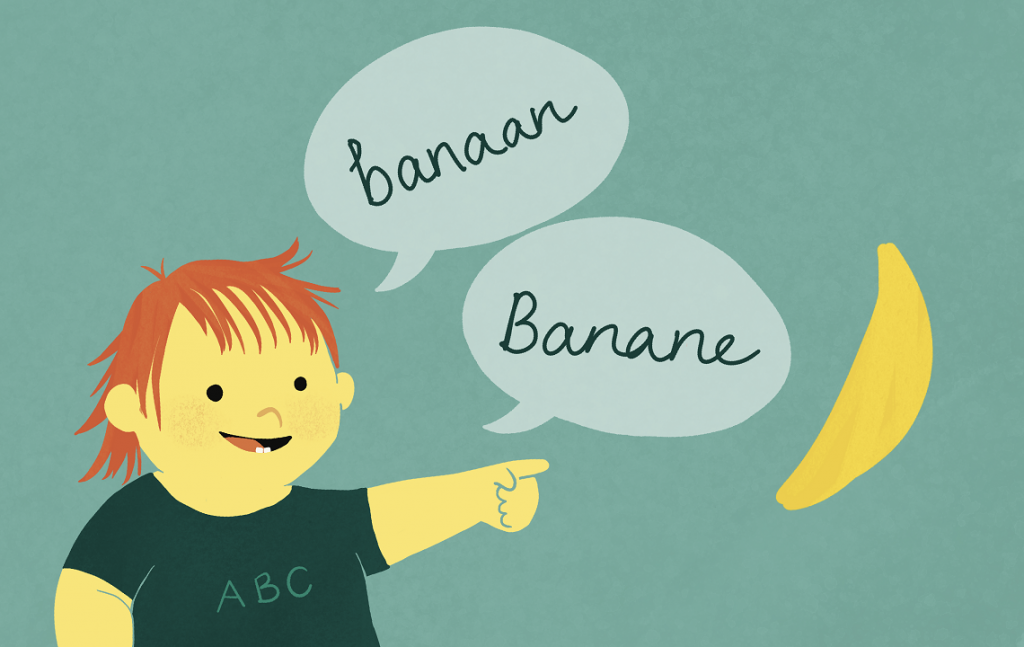At home she learns German, at daycare she learns Dutch. During the two months of the last lockdown, daycare was closed and German became the only language she was exposed to. Occasionally, she would video call her grandparents, who read books to her, also in German. This had the effect that her use of German skyrocketed to the extent that she was almost exclusively speaking it. I was concerned about how she would fare going back to daycare, and whether we needed to stimulate her Dutch. Indeed, after the months at home, her first weeks back at daycare were tough. Luckily, her carers managed to understand what she was trying to say every time, and in no time, she was back to speaking Dutch again. Now, with three days at daycare and the rest of the time at home, she certainly still hears more German than Dutch – yet she predominantly chooses to speak Dutch. My concern shifted 180 degrees: Why won’t she speak German anymore?
When I shared my worries with Sharon Unsworth, associate professor at Radboud University, who works on child bilingualism, she was not surprised. “This is the Number One concern of parents raising bilingual children,” she says, “but don’t give up hope!” She explains that it’s actually quite common for young children to mostly speak in the majority language (that is, the language spoken by the majority of people in a given country). Although my daughter may spend the majority of the week hearing German, any time we go to the shops or to playgrounds or the library, she will hear Dutch – both from others but also from her parents. Dutch simply is more present in her life. Unsworth notes that this pattern of using the majority language is similar across many children growing up bilingually, regardless of how similar their two (or more) languages are. But, as Unsworth also notes, “bilingualism is very dynamic,” and so while a child may prefer to speak the majority language now, it might not always be like that. As a result, they may use their heritage language (that is, the language spoken at home) sometimes less, sometimes more.
“So should I stimulate her German?” I ask. “Where would you like your child to be when they are older?” Unsworth asks back. I want my daughter to be able to form meaningful connections, not only with the Dutch-speaking people she interacts with on a daily basis, but also with our friends and family who don’t speak Dutch. Unsworth explains that just by speaking two (or more) languages to a child, we cannot expect them to effortlessly learn and continue to speak both languages fluently. Especially if a child goes to school in their majority language, it may be worthwhile investing in their other language. But how? I’ve learned that it takes more than just asking my daughter to speak German; as is common for many three-year-olds, oftentimes asking her to do something results in her not wanting to do it! Stimulating language use takes a tailored approach, specific to the child, resources, home situation, and cultural background, Unsworth explains. In our case, I often repeat in German what my daughter says in Dutch. This allows her to directly map the meaning from the Dutch word to its German translation, and also encourages her to continue the conversation in German. Creating opportunities where she cannot switch, such as visits from family members who speak only German, especially when they involve other kids, is another way to stimulate her heritage language.
Another thing I noticed is that at times my daughter will mix her languages, resulting in words or sentences that are German and Dutch. For example, she learned that the Dutch word vlinder means “butterfly”, and then created the word Vlinder-Maus to describe a bat. This sounds similar to Fledermaus, which is the German translation of bat, and clearly made sense to her because vlinders and bats both fly. Using both languages in the same sentence or conversation, Unsworth notes, is not in itself a problem. Instead of fretting about my daughter’s language skills when she mixes her languages, Unsworth suggests I should see this mixing as creativity. Besides, “What is perfect German?” she asks. And she is right; although I was raised monolingually, I now regularly mix English and Dutch into my German. “I think we need to stop making the bilinguals fit into the monolingual world, and get the monolinguals a bit more used to the fact that most of the world is bilingual,” she says.
Next year, my daughter will start school. She also recently became a big sister, so now there’s another little bilingual language learner in the household. Undoubtedly, their interaction with one another will affect their language use. For example, school-aged kids bring the majority language home, which leads to their younger siblings having a better developed majority language, too. But what will this mean for their heritage language? Going back to the idea of dynamic bilingualism, different parameters may be relevant at different times during bilingual language learning: The ways in which I stimulate her use of German now in her daycare years might change when she goes to school. As she gets older, her language use will become more complex, she will have more conversations, and she will likely learn additional languages at school. Unsworth thinks it’s important to regularly reflect on new circumstances as children grow up, review one’s bilingualism goals, and adapt to the changing contexts when trying to stimulate the heritage language(s). I cannot wait to see how my children’s language will develop in the coming years!
Want to learn more about bilingualism in children? Check out Sharon’s podcast Kletsheads, available in Dutch (https://kletsheadspodcast.nl/) and in English (https://kletsheadspodcast.org).
Writer: Julia Misersky
Editors: Guillermo Montero Melis
Dutch translation: Ava Creemers
German translation: Julia Misersky
Final editing: Eva Poort

